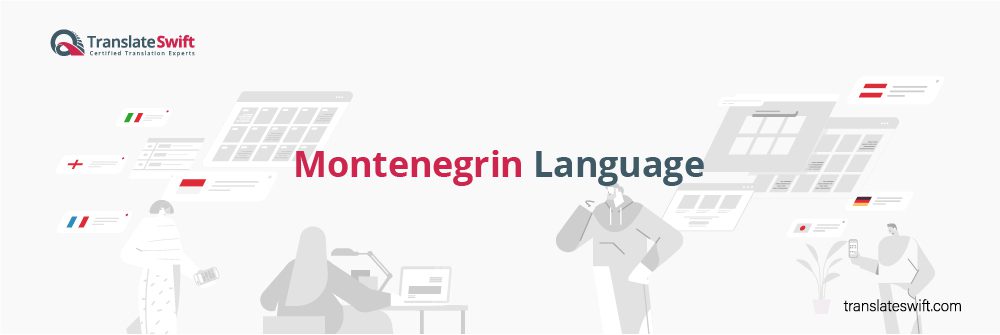
The Rise of Montenegrin
Montenegrin language, the official language of Montenegro, boasts a fascinating history that’s famously linked to the country’s quest for national identity. Unlike many European languages with roots stretching back centuries, Montenegrin’s emergence as a distinct standard language is a recent phenomenon. For centuries, it primarily existed as a dialect of Serbian.
Both languages belong to the South Slavic branch of the Indo-European family so they share a close resemblance. Cyrillic script is the traditional writing system, though the Latin alphabet is gaining traction in Montenegro, particularly among younger generations.
Following the dissolution of Yugoslavia in the 1990s, Montenegro declared independence, fostering a burgeoning national identity. This newfound sense of self fueled the codification of Montenegrin as a separate language in 2007.
However, this move ignited debate among linguists. Some argued that the linguistic differences between Montenegrin and Serbian were relatively minor, primarily focused on pronunciation and a slightly streamlined grammar.
Subtle Distinctions
Despite its close kinship with Serbian, Montenegrin possesses some unique characteristics that go beyond just pronunciation. Notably, it employs the “ijekavian” pronunciation for specific vowels, a feature also found in some western Serbian dialects. This pronunciation emphasizes a distinct sound for these vowels, adding a subtle layer of differentiation.
Montenegrin also boasts a slightly simpler grammar, with some verb conjugations and noun declensions streamlined compared to Serbian. This can be attributed to the historical influences of neighboring languages like Italian and Albanian, which have a reputation for being less complex grammatically.
Beyond Borders
Montenegrin serves as the official language of Montenegro, spoken primarily within its borders. A small diaspora community carries the language with them, particularly in neighboring Serbia and across Europe. Efforts are underway to standardize educational materials and promote Montenegrin literature, solidifying its place in the national identity.
A Growing Vocabulary
Perhaps the most exciting aspect of Montenegrin’s development is its evolving vocabulary, which acts as a living record of the country’s unique identity. As the language becomes more established, new words are being coined to capture the essence of the Montenegrin experience. This linguistic tapestry encompasses everything from the region’s specific flora and fauna – like “ljubičica” (Montenegrin primrose) and “sivi soko” (golden eagle) – to cultural practices deeply rooted in local traditions.
Words like “koljeno” (smoked meat dish) and “gusle” (one-stringed fiddle) paint a picture of Montenegrin cuisine and music, while terms like “filotimo” (hospitality) and “momci” (masked carnival figures) showcase the country’s social values and customs. This ongoing development allows Montenegrin to not only function as a means of communication but also strengthen Montenegrin identity, preserving its cultural heritage for future generations.
Preservation Efforts
The future of Montenegrin relies on continued use and development. Educational initiatives are making it more accessible to younger generations, evident in the growing popularity of the Latin alphabet. This shift reflects a desire for easier communication with the West and aligns with Montenegro’s aspirations for European integration, where Latin script dominates.
Professional Montenegrin Translation Services
At TranslateSwift, we bridge the communication gap between languages and cultures. Our team of expert linguists, with a deep understanding of Montenegrin’s nuances, provides accurate and culturally sensitive translations for all your needs. We handle student documents, business contracts, personal certificates, and more, ensuring seamless communication across borders.
Other Languages
- English
- Spanish
- German
- Dutch
- French
- Italian
- Afrikaans
- Albanian
- Amharic
- Arabic
- Armenian
- Azerbaijani
- Basque
- Belarusian
- Bengali
- Bosnian
- Bulgarian
- Cantonese
- Catalan
- Cebuano
- Chichewa
- Chinese - Simplified
- Chinese - Cantonese
- Chinese - Traditional
- Chinese - Mandarin
- Corsican
- Croatian
- Creole
- Czech
- Danish
- Dari
- Esperanto
- Estonian
- Farsi
- Filipino
- Finnish
- Frisian
- Galician
- Georgian
- Greek
- Gujarati
- Haitian Creole
- Hausa
- Hawaiian
- Hebrew
- Hindi
- Hmong
- Hungarian
- Icelandic
- Igbo
- Indonesian
- Irish
- Japanese
- Javanese
- Kannada
- Kazakh
- Khmer
- Korean
- Kurdish
- Kyrgyz
- Lao
- Latin
- Latvian
- Lithuanian
- Luxembourgish
- Macedonian
- Malagasy
- Malay
- Malayalam
- Maltese
- Maori
- Marathi
- Mongolian
- Montenegrin
- Myanmar
- Nepali
- Norwegian
- Odia
- Pashto
- Persian
- Polish
- Portuguese
- Punjabi
- Romanian
- Russian
- Samoan
- Scots Gaelic
- Serbian
- Sesotho
- Shona
- Sindhi
- Sinhala
- Slovak
- Slovenian
- Somali
- Sundanese
- Swahili
- Swedish
- Tajik
- Tagalog
- Tamil
- Telugu
- Thai
- Turkish
- Ukrainian
- Urdu
- Uyghur
- Uzbek
- Vietnamese
- Welsh
- Xhosa
- Yiddish
- Yoruba
- Zulu
